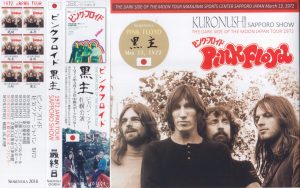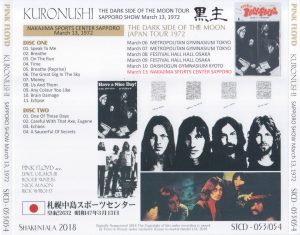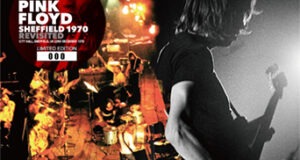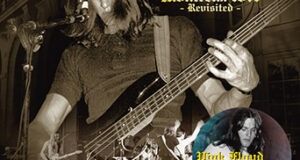Pink Floyd / Kuronushi 1972 / 2CD With OBI Strip / Shakuntala
Nakajima Sports Center Sapporo March 13, 1972. Digitally Remastered
Play sample :
Click Image to Enlarge
Many artists came to Japan from the early 1970s, which can be said to be the dawn of Japanese rock, and at the time when information was limited, there were many opportunities to actually witness overseas artists that could only be known from books until now. It was a dreamlike time. And Pink Floyd’s performances in Japan have been held three times so far. He first came to Japan in 1971, and in 1972 he also performed in Japan. Surprisingly, when I first arrived in Tokyo, there were no concerts, and there were only three stages, two in Hakone and one in Osaka. Perhaps the fans living in Tokyo first came into contact with the Pink Floyd stage in 1972 when they came to Japan for the second time.
Pink Floyd finished his tour with the release of “Nosy” in November 1971, after which he would spend time recording his next album again. The theme of the next work was to express “the madness hidden inside human beings” with music. Such esoteric themes and complex compositions come to fruition as “madness” after many elaborations, but the release had to wait in March 1973. Moreover, the tour schedule is set during that time, and Floyd will choose to improve the level of “madness” through the tour. In fact, “madness” has already been shown on the already scheduled UK tour that began in early 1972.
“Insanity” has now firmly established its position as a historical masterpiece, including chart action, but at that time it was staged as a pure Pink Floyd new song. In contrast to the “madness” that most audiences will hear for the first time, the world view already creates an atmosphere that is not ordinary, and it seems that they are just watching the fantastic sight that unfolds on the stage with a sigh of breath. It can be seen from the audience recording at that time. The 1972 performance in Japan was an extension of that series. Here too, the unreleased “Insanity” has already been performed throughout the entire volume from the opening.
What is a stage for an artist? Paul McCartney recalls, “Even in the Beatles era, songs like’She Loves You’were more popular than new songs.” It is a well-understood testimony that the audience is enjoying listening to the songs that they have listened to on the records live at the concert hall. Also, from the artist’s point of view, it may have been the intention to directly confirm the reaction of the song by showing off the new song. A tour was organized during the album production, and it seems that the intention was to reflect the reaction on the stage in the album production during the recording process. Also, this is a phenomenon that occurs due to the time difference between recording and release, but it seems that there was also an intention as a promotion, such as having people purchase an album that will be released later because they want to listen to the new song played on the stage again. That’s probably why Led Zeppelin was actively playing songs from his new album, which had already been recorded but hadn’t been released yet.
But in the case of Pink Floyd, there seems to be another reason why it doesn’t belong to any of the above. On the stage of 1972, the entire “Insanity” was performed from the opening, but after all, he is playing the entire album more than a year before the release. And although the “madness” that can be heard in this work is the “madness” whose skeleton was released, the impression that it is incomplete cannot be dispelled. It’s a different version that sounds like you’re listening to a studio outtake rather than an unfinished one. If the most different version has a bad word, would the expression “not yet matured” be more appropriate? Pink Floyd may have had a special consciousness about “madness.” I imagine that there was an unprecedented intention to improve the skill and approach the perfect final form by playing repeatedly throughout the tour.
When Fujiko Fujio, who was a student, visited Tezuka Osamu’s home for the first time, there were originally 1000 pages of manuscripts for the “coming world” of only 300 pages, and 700 pages of scraped support support the dense work. There is an episode that surprises me when I find out about it. Pink Floyd’s “Insanity” is such a tight work that the tension does not relax from beginning to end, and it is said that it is the result of aging on the stage over a year like this. I can understand things well. Only the album “The Dark Side of the Moon” will remain for posterity, but fans who attended the live at that time were fortunate to know that such a long aging period supported the masterpiece. ing. Part of that is the 1972 Japan performance recorded in this work.
In 1972, there were 6 performances in Japan, 2 in Tokyo, 2 in Osaka, and Kyoto and Sapporo. The schedule is hard even if you look at it now that the transportation network is well developed, and especially from Tokyo to Kyoto, there are five consecutive performances. This work records the first day of the performance in Sapporo on March 13, 1972. As mentioned above, “Insanity” is played in full in the first half. What is interesting is the content that Goro Itoi makes an announcement after the first half is over. Initially, it was introduced as “A Piece for Assorted Lunatics” on the stage in January, but as of this March, the title has already changed to “The Dark Side Of The Moon”. The point that there is no Japanese title “Crazy” yet. At the venue on the day of the event, the lyrics card “The other side of the moon-works for various madmen-” was distributed to the audience. And the point that it is introduced as a new song released in the UK in November. The release scheduled for November was delayed by four months until March of the following year, probably because of Pink Floyd’s desire for perfection.
The first half plays the entire “madness”, with announcements and breaks, and the second half is lined with already released songs. “One of These Days, Call me ARASHI” was a song that symbolized Pink Floyd for Japanese fans at the time, which was widely sung in tour posters. In addition, Eugene, Echoes, and mystery conclude the concert. In the latter half of Disc 2, another source of the same day that was aired on the radio at that time is recorded. It’s interesting that the DJ said after the broadcast, “What kind of band in which country is it?” This is also a trace of a rough era.
From Pink Floyd’s 1972 performance in Japan, the first day, March 13th, Sapporo is completely recorded. A press board with beautiful picture disc specifications for permanent storage. With Japanese obi.
日本のロック黎明期ともいえる70年代初頭から数多くのアーティストが来日し、情報が限られていた当時、今まで書籍でしか知ることの出来なかった海外アーティストを実際に目の当たりにする機会が多く、まるで夢のような時代であった。そしてピンク・フロイドの来日公演は今まで3回行なわれている。初来日が1971年、そして翌1972年にも来日公演を行なっている。驚くべきことに初来日時は東京ではコンサートは行なわれず、箱根で2度、大阪で1度の、計3回のみのステージであった。おそらく東京在住のファンは、1972年、2度目の来日でピンクフロイドのステージに初めて接したのではないだろうか。
ピンク・フロイドは1971年11月に「おせっかい」リリースに伴うツアーを終え、その後再び次のアルバムのレコーディングに時間を費やすことになる。そして次作のテーマとして掲げられたのが「人間の内面に潜む狂気」を音楽で表現することであった。このような難解なテーマと複雑な構成は、何度も推敲が重ねられ後、『狂気』として結実するが、リリースは1973年3月で待たねばならなかった。しかも、その間もツアー日程は組まれており、フロイドはツアーを通して『狂気』の練度を上げていく選択をすることになる。実際に、既に予定されていた1972年の年初から始まった英国ツアーでは、早くも『狂気』が披露されている。
今でこそチャート・アクションを含め歴史的名盤の地位を確固たるものとしている『狂気』であるが、当時は純粋なピンクフロイドの新曲としてステージされている。ほとんどの聴衆にとって初めて聴くであろう『狂気』に対し、その世界観は既に只者ではない雰囲気を醸しており、ステージで展開される幻想的な光景にただ固唾を飲んで見守っている様子が当時のオーディエンス録音から伺える。その一連の延長で行なわれたのが1972年の来日公演であった。ここでも未発表だった『狂気』がオープニングから既に全編を通して演奏されている。
アーティストにとってステージとは何であろうか。ポールマッカートニーは「ビートルズ時代でも新曲より『シー・ラヴズ・ユー』といった曲の方がウケた」と述懐している。観客はレコードで擦り切れるほど聴いた曲をコンサート会場で生演奏で聴くことに楽しみを感じているのがよく理解できる証言である。またアーティスト側の視点では、新曲を披露することで曲の反応をダイレクトに確かめるという意図もあったのではないか。アルバム制作中にもツアーが組まれており、レコーディングの過程で、ステージにおける反応をアルバム制作に反映させる意図があったと思われる。またこれはレコーディングとリリースの時間差から生じる現象だが、ステージで演奏した新曲を再度聴きたいがために後にリリースされるアルバムを購入してもらうといった、プロモーションとしての意図もあったと思われる。レッド・ツェッペリンが既にレコーディング済でありながら未リリースのニューアルバムの曲を積極的にステージで演奏していたのも、おそらくそのような理由からであろう。
しかしピンク・フロイドの場合は、上記のいずれにも属さないまた別の理由があるように思える。1972年のステージでは『狂気』全編がオープニングから演奏されているが、なにせリリースより1年以上前のアルバムをまるごと演奏しているのである。そして本作などで聴くことが出来る『狂気』は、骨格こそリリースされた『狂気』であるものの、はっきり言って未完成の印象を払拭できない。未完成というよりもスタジオ・アウトテイクを聴いているような別バージョンなのである。最も別バージョンというのが語弊があるのであれば、まだ熟成されていないという表現の方がピタリとくるであろうか。ピンク・フロイドにとっても『狂気』に対しては特別な意識があったのだろう。ツアーを通して繰り返し演奏することによって練度を高め完璧な最終形に近付けていこうという、従来にない意図があったのではと想像する。
学生時代の藤子不二雄が初めて手塚治虫の自宅を訪れた際、わずか300ページの「来るべき世界」に対し、元々1000ページもの原稿があり、削った700ページ分があの濃密な作品を支えている事を知り驚愕するエピソードがある。ピンクフロイドの『狂気』があのように隙がなく、終始緊張感が弛緩することなく濃密な作品となっているのは、このように1年かけてステージで熟成させていった結果なのだという事がよく理解できる。後世の人たちにはアルバム『狂気』のみが残るであろうが、当時、ライヴに臨場したファンは、幸運にもこのように、長期に渡る熟成期間があの名盤を支えている事を知っている。その一端が、本作に収録の1972年日本公演なのである。
1972年の日本公演は東京2回、大阪2回、そして京都と札幌と、合計6公演が行なわれている。交通網の発達している現在の目で見てもハードなスケジュールで、特に東京から京都までは5日連続公演である。本作はその初日1972年3月13日札幌公演を収録している。前述のように前半は『狂気』がフルで演奏されている。興味深いのは前半が終了した後に糸居五郎がアナウンスを入れる内容である。当初1月のステージでは『A Piece for Assorted Lunatics』と紹介されていたが、既にこの3月の時点で『The Dark Side Of The Moon』とタイトルが変わっている点。『狂気』という日本語タイトルはまだないという点。なお、当日会場では『月の裏側-もろもろの狂人達の為への作品-』という歌詞カードが観客に配布されたとのことである。そして11月に英国でリリースされる新曲であると紹介している点。11月を予定していたリリースが翌年3月にまで4か月もずれ込むのは、やはり完璧を求めるピンク・フロイドの拘りだったのだろう。
前半が『狂気』全編を演奏し、アナウンスと休憩を挟み、後半は既にリリース済みの楽曲群が並ぶ。「吹けよ風、呼べよ嵐」はツアーポスターにも大々的に謳われた当時の日本のファンにとってピンク・フロイドを象徴する曲であった。その他、ユージン、エコーズ、そして神秘でコンサートは締めくくられる。なお、ディスク2の後半には当時ラジオでオンエアされた同日の別ソースが収録されている。さすがにマズいと思ったのか、放送後にDJが「どこの国の何というバンドでしょうねえ」とトボけた事を言っているのが面白い。これもまた大らかな時代の痕跡であろう。
ピンク・フロイドの1972年来日公演より、初日3月13日札幌を完全収録。美しいピクチャー・ディスク仕様の永久保存がっちりプレス盤。日本語帯付。
NAKAJIMA SPORTS CENTER SAPPORO March 13, 1972
DISC ONE
01. Speak To Me
02. Breathe
03. On The Run
04. Time
05. Breathe (Reprise)
06. The Great Gig In The Sky
07. Money
08. Us And Them
09. Any Colour You Like
10. Brain Damage
11. Eclipse
DISC TWO
01. One Of These Days
02. Careful With That Axe, Eugene
03. Echoes
04. A Saucerful Of Secrets
Shakuntala. STCD-053/054
 GiGinJapan Artwork of Japanese CDs (mostly)
GiGinJapan Artwork of Japanese CDs (mostly) 




